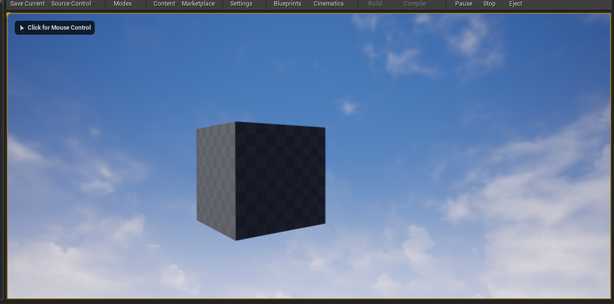基于C++代码的UE4学习(八)—— 自定义代理结合Timer实现道具的消失与重生
2021-04-23 06:28
标签:icm cube world class handle err nts ue4 ++ 依照题目可以知道我们今天要实现的功能是道具的消失与重生。 这里就涉及到道具如何消失,如何重生的问题。 我们规定: 当StartPlayer触碰到道具的时候,道具就消失,间隔5秒钟之后,道具再次在原点重生。 文中的提及的Cube类是AMyActor_Cube类的简称。 文中的提及的Spawn类是AMyActor_Spawn类的简称。 先定义一个ACTOR类的派生类,作为道具,载入任意一个模型即可,这里是载入了Cube模型,并增加了Box类型碰撞体。 以下是Cube类的头文件代码: 请注意第10行,我们宣布了一个代理,这个代理是自己自定义的,也就是说,名字是随便起的。 在32行声明了一个该代理的对象。 以下是Cube类的源文件代码: 当Cube类的对象被overlap的时候,就会触发代理执行。 那具体执行什么呢?当然是执行消失与重生了。我们再创建一个ACTOR类的派生类Spawn,用于管理Cube类的消失与重生功能。 由于需要定时重生,所以这里肯定会用到FTimerHandle结构体(之前文章都习惯性的说成类,理解意思就好)。 以下是Spawn类的头文件代码: 新定义两个方法,一个方法用于重生Cube,一个方法用于管理Cube。 既然是要和Cube类的对象发生交互,千万不要忘记导入Cube类的头文件。. 以下是Spawn类的源文件代码: 先来设计生成Cube类对象的代码,在spawmActor方法中,在世界里产生一个AMyActor_Cube类的实例,并将该实例的代理绑定在Spawn类中的managementActor方法上。 也就是说,当Cube类的对象被Overlap的时候,会开始执行这个被绑定的managementActor方法。 managementActor方法触发后,会每隔5秒钟,调用spawnActor方法,以此往复,这里需要注意的是managementActor里的Timer的LOOP属性设定必须给到false,否则会不断复制,造成管理失控。 因为触碰到Cube类的对象后,该对象会消失,所以Spawn类中的Cube类的指针指向的代理得先解绑,再将对象销毁。 效果图如下: 触碰后物体消失,左上角有提示信息 过5秒钟之后,再次产生一个Cube类的对象。 基于C++代码的UE4学习(八)—— 自定义代理结合Timer实现道具的消失与重生 标签:icm cube world class handle err nts ue4 ++ 原文地址:https://www.cnblogs.com/dlak/p/13272550.html 1 // Fill out your copyright notice in the Description page of Project Settings.
2
3 #pragma once
4
5 #include "CoreMinimal.h"
6 #include "GameFramework/Actor.h"
7 #include "MyActor_Cube.generated.h"
8
9
10 DECLARE_DELEGATE(MyDelegateSignature)
11
12 UCLASS()
13 class MYPROJECT5_API AMyActor_Cube : public AActor
14 {
15 GENERATED_BODY()
16
17 public:
18 // Sets default values for this actor‘s properties
19 AMyActor_Cube();
20
21 protected:
22 // Called when the game starts or when spawned
23 virtual void BeginPlay() override;
24
25 public:
26 // Called every frame
27 virtual void Tick(float DeltaTime) override;
28
29 public:
30 class UStaticMeshComponent* myStaticMesh;
31 class UBoxComponent* box;
32 MyDelegateSignature mySig;
33 virtual void NotifyActorBeginOverlap(AActor* actor)override;
34 FRotator rotate;
35 };
1 // Fill out your copyright notice in the Description page of Project Settings.
2
3
4 #include "MyActor_Cube.h"
5 #include "Components\StaticMeshComponent.h"
6 #include "Components\BoxComponent.h"
7 #include "UObject\ConstructorHelpers.h"
8 #include "Engine.h"
9
10
11 // Sets default values
12 AMyActor_Cube::AMyActor_Cube()
13 {
14 // Set this actor to call Tick() every frame. You can turn this off to improve performance if you don‘t need it.
15 PrimaryActorTick.bCanEverTick = true;
16
17 myStaticMesh = CreateDefaultSubobject
1 // Fill out your copyright notice in the Description page of Project Settings.
2
3 #pragma once
4
5 #include "CoreMinimal.h"
6 #include "GameFramework/Actor.h"
7 #include "MyActor_Cube.h"
8 #include "MyActor_Spawn.generated.h"
9
10 UCLASS()
11 class MYPROJECT5_API AMyActor_Spawn : public AActor
12 {
13 GENERATED_BODY()
14
15 public:
16 // Sets default values for this actor‘s properties
17 AMyActor_Spawn();
18
19 protected:
20 // Called when the game starts or when spawned
21 virtual void BeginPlay() override;
22
23 public:
24 // Called every frame
25 virtual void Tick(float DeltaTime) override;
26
27 public:
28 UPROPERTY()
29 class USceneComponent* scene;
30
31 UFUNCTION()
32 void spawnActor();
33
34 UFUNCTION()
35 void managementActor();
36
37 UPROPERTY()
38 FTimerHandle myTimer;
39
40 UPROPERTY()
41 AMyActor_Cube* myActorCube;
42 };
1 // Fill out your copyright notice in the Description page of Project Settings.
2
3
4 #include "MyActor_Spawn.h"
5
6 // Sets default values
7 AMyActor_Spawn::AMyActor_Spawn()
8 {
9 // Set this actor to call Tick() every frame. You can turn this off to improve performance if you don‘t need it.
10 PrimaryActorTick.bCanEverTick = true;
11 scene = CreateDefaultSubobject



文章标题:基于C++代码的UE4学习(八)—— 自定义代理结合Timer实现道具的消失与重生
文章链接:http://soscw.com/index.php/essay/78429.html